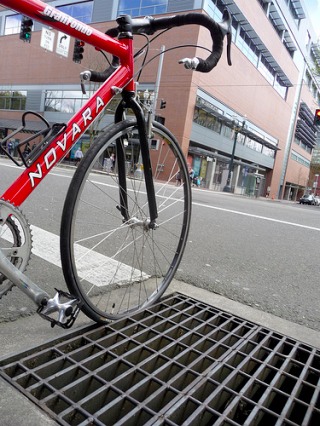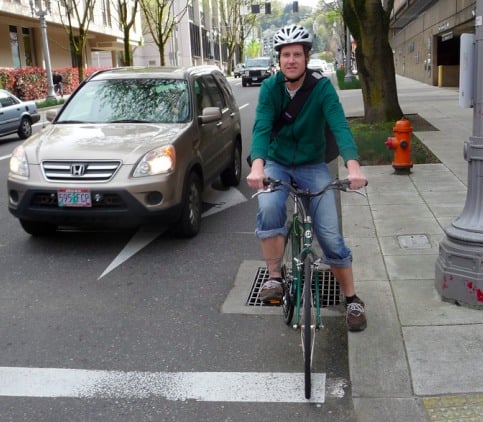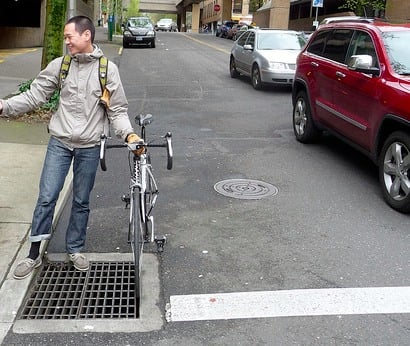
Portland is wider than a bike tire.
(Photos: Jim Parsons)
Super citizen activist Jim Parsons is at again. And this time, he’s mad about a bike-wheeling eating storm drain smack dab in the middle of downtown Portland and what he feels is a lack of action by the City to fix it.
Parsons has garnered quite a reputation for his tenacious, street-level activism that focuses on roadway hazards like overgrown vegetation (he carries pruning sheers in his panniers), potholes (he carries spray paint to mark them), and especially, storm drain grates (he’ll lift and turn them himself if possible so any gaps are perpendicular to traffic). (Learn more about him in our profile from a few years back.)
Last week, Jim found a prime example of a hazardous storm drain grate that, “could pose a bicycle safety hazard” on the southwest corner of SW 6th and Harrison (across from the PSU Bike Hub). Jim called the City’s 24-hour maintenance hotline (on speed-dial of course) and emailed a few contacts about it (along with a photo). “In this photo,” he wrote, “you can see my friend’s bike’s tire can easily slip inside the gap. If he had been riding when that happened, we can imagine the results.”
Jim says its a common problem he comes across: A grate that is too small for the opening it sits in and therefore a gap is created along one edge. As backup to his concerns, Jim cites Oregon Revised Statute 810.150 that states, “… storm drains… shall be designed and installed… with grates or covers so that bicycle traffic may pass over the drains safely and without obstruction or interference.”


After several days passed, Jim kept widening the CC list on his emails and continued to ask for answers. He eventually worked his way up to Kelly Shephard, the City of Portland’s Senior Public Works Supervisor.
Shephard left a voicemail for Jim about the issue; but it wasn’t the answer Jim was hoping for. In the voicemail, Shephard said the gaps are necessary and “designed” into the drains, “so that the workers can get them out.” Shephard added that his employees have experienced back injuries when debris clogs up in narrow gaps and makes the grates harder to remove.
“They have to be able to be removed when they need to be cleaned out, and without those gaps, they would not be able to remove them,” Shephard said in the voicemail.
Then Shephard suggested that people traveling by bike steer clear of the grates:
“I would encourage bicyclists to avoid catchbasin grates when they are riding… I would encourage bicyclists to ride over the middle of the grate as much as possible to avoid that edge…”
In a follow-up email, Shephard advised Jim to contact PBOT’s specifications manager if he’d like to pursue a formal change to the policy. “Please remember though,” Shepard added, “all proposed changes must take into account both worker and public safety.”
Here’s how Jim sees it:
“It’s my belief that larger gaps should be along the short end of the rectangle (perpendicular to traffic direction) to allow for the needed leverage for installation/removal. I also feel that a smaller gap is required for the longer edge of the rectangle (parallel to traffic). Is it really necessary for gaps as much as 7/8ths of an inch (parallel to traffic) to allow for removal and maintenance?”
This is an interesting issue. Is the way workers remove a storm drain grate more important than fixing what is clearly a safety hazard to road users? Does PBOT have places on the roadway where they’d advise people driving cars to avoid due to safety concerns?

